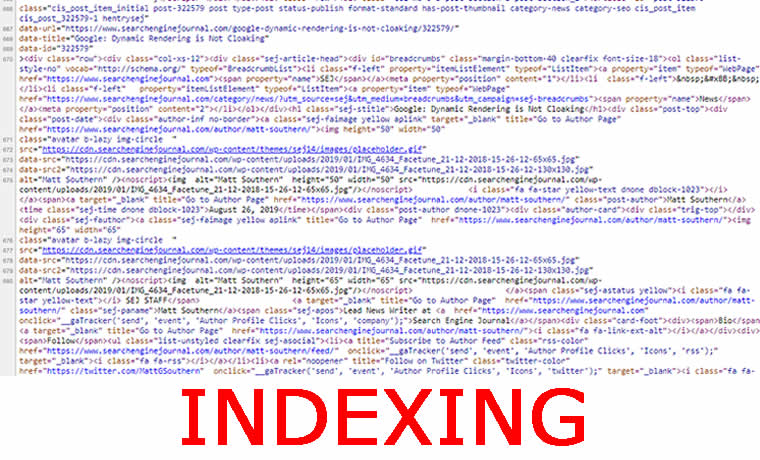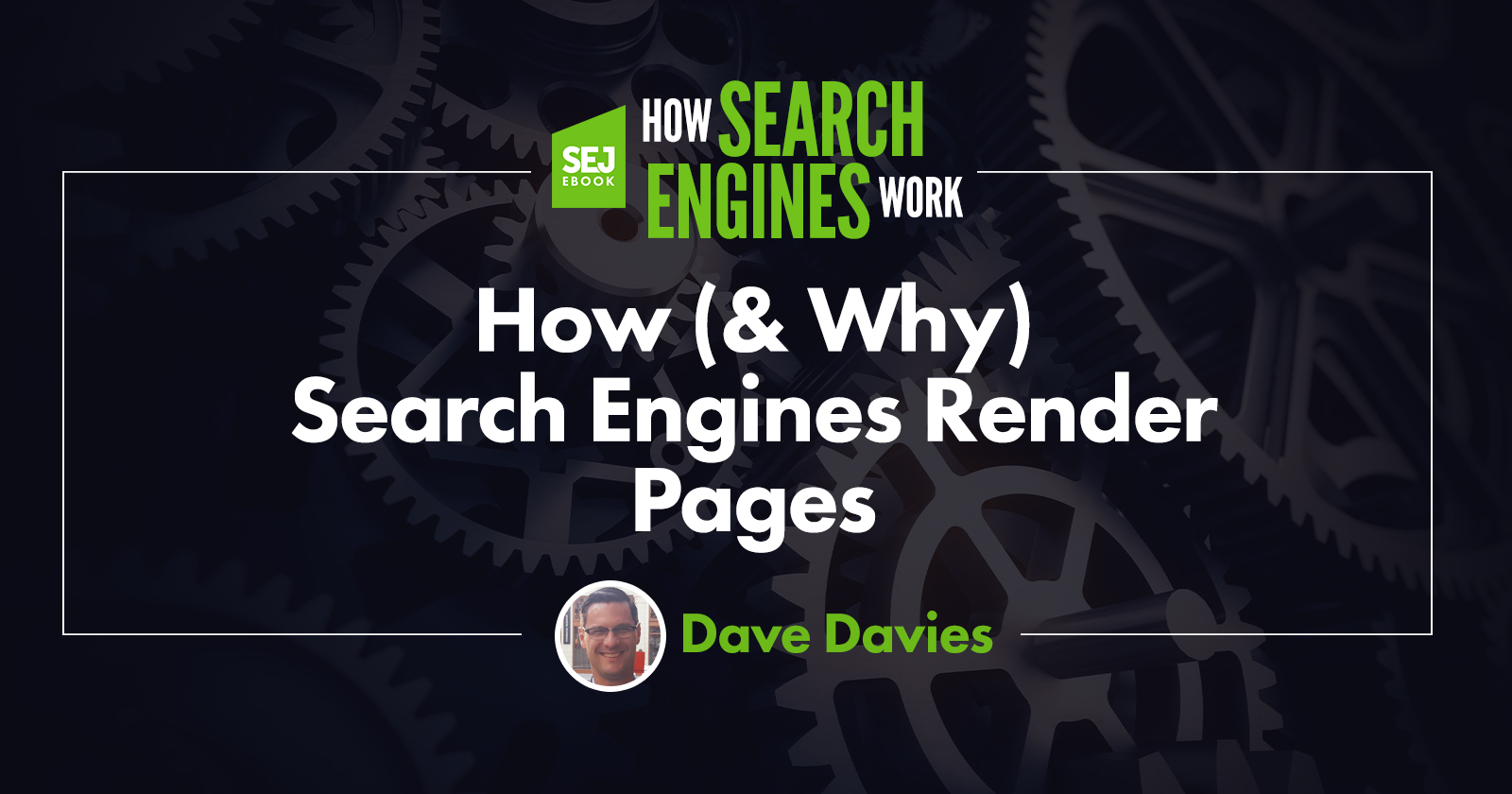There is an interesting twist in how we think about indexing – and that is rendering.
When we think about ranking pages, we generally think about indexing.
That is to say, we generally think about the point in time when a search engine has:
- Discovered a page through sitemaps or crawling and has proceeded to then visit the page for indexing.
- Gathered all the content via the page source.
- Started ranking the page for queries.
Historically, this has been the most important set of steps in the process as it is the trigger for rankings.
However, indexing isn’t the final stage of the discovery process.
I would suggest that its weight will decline in time while the final stage – rendering – increases and I suspect replaces the indexed version altogether.
Indexing vs. Rendering: What Is the Difference?
Essentially, the difference between indexing and rendering can be illustrated with these two images:
This is indexing:

This is rendering:

This is basically the same content, viewed as it would be during indexing (HTML) and rendering (Chrome).
Why Does This Matter?
Rendering is more important than you might think.
The fact that search engines rendered pages prior to the recent push into JavaScript use for websites, is a good confirmation.
Essentially the reason that it matters is that rendering provides the truth.
With the code, a search engine can understand what a page is about and roughly what’s going on.
With rendering, they can understand the user experience and far more about what content should take priority.
With rendering, they can answer questions like:
- Is content hidden behind a click?
- Does an ad fill the page?
- Is content that appears towards the bottom of the code, actually displayed towards the top or in the navigation?
- Is a page slow to load?
All these questions, and many more, are answered during rendering.
These answers are important to properly understand a page and how it should be ranked.
When Does Rendering Occur?
In 2018, rendering took weeks.
Not surprisingly, it takes far less time now.
Seconds in fact.
At about the 18:20 mark in the audio here, you’ll hear Google’s Martin Splitt answer just this question.
How Long Until Google Renders A Page?
The medium is 5 seconds, and within minutes 90% of indexed pages will be through the rendering queue.
It needs to be noted that this is queueing, not necessarily rendering.
That is to say, if you are on the positive side of the medium set that begins within 5 seconds, your page will begin rendering inside 5 seconds, though it may not complete within that time.
If rendering begins in 4 seconds but takes 30 seconds to complete, it would be considered among those counted in the positive side of the medium set.
We’ve come a long long way in 2 years, from weeks to seconds.
Bing operates differently.
When I asked their Web Ranking & Quality Project Manager, Frédéric Dubut, he responded:
Same answer as before, between minutes and forever 🙂 but I can confirm we're trying to prioritize rendering for the URLs submitted through the API.
— Frédéric Dubut (@CoperniX) August 3, 2020
The “before” he is referencing was my Tweet from last September:
I would say the same – sometimes it's days, it can be weeks and in extreme cases it can also be never. Ultimately it's a trade-off between the cost of rendering the page and the value we find in rendering it.
— Frédéric Dubut (@CoperniX) September 3, 2019
Presumably, they too have sped things up, though I don’t have a newer confirmation on time.
So, the short answer as to when rendering takes place is: “after indexing” and the timeline is variable but short, essentially meaning that the search engines will understand the content and context of a page prior to gaining a full understanding of how it is to be prioritized, but in most cases the lag is moot.
Googlebot Evergreen
A big leap forward took place in May of 2019 when Googlebot’s Web Rendering Service (WRS) component was updated.
Until then, the Web Rendering Service was using Chrome version 41.
While this was great for compatibility, it was a nightmare for sites that relied on modern features of JavaScript.
In May 2019, the Web Rendering Service was upgraded to evergreen, meaning that it uses the most current version of Chrome for rendering (within a couple of weeks at any rate).
Essentially, now when your page is rendered by Google, it’s rendered more-or-less how you would see it in your browser.
What Does a Web Rendering Service Do?
I wanted to quickly answer a question that I found myself not quite wrapping my brain around until I realized I was thinking about it entirely wrong.
You are welcome to laugh at me for the obviousness of the hiccup in my brain.
First, let’s consider where a Web Rendering Services gets its instructions and how.
Here’s basically the life-cycle of rendering:
- A page is discovered via sitemap, crawler, etc.
- The page is added to the list of pages to be crawled on a site when the crawl budget is available.
- The page content is crawled and indexed.
- The page is added to the rendering queue.
- The page in rendered.
So, a critical and unspoken element of the process is the rendering queue.
When a page hits the top of the queue for rendering, the engine will send what is referred to as a headless browser to it.

This is the step I had difficulty with.
A headless browser is a browser without a graphical user interface.
For some reason, I had a difficult time wrapping my brain around how that worked.
Like, how is Google to know what’s there if it’s not graphically displayed?
The obvious answer is:
“The bot doesn’t have eyes either so … um … yeah.”
Over that mental hiccup, I came to terms with it as a “browser light” that renders the page for the search engine to now understand what appears where and how on a page – even though they don’t have eyes to see it.
When all goes well, the rendered version will appear the same to Googlebot as it does to graphical browsers, and if it doesn’t then it’s likely because the page relies on an unsupported feature like a user permission request, or one of the scripts or other resources errored.
What About Pre-Rendering?
Pre-rendering is the use of a library like Puppeteer (the one I’m most familiar with so used as the example) to create cached HTML copies of JavaScript pages, and serving those caches to Google.
Basically, it’s an ethical form on cloaking, where you make a copy of the page as it would appear in the DOM, and serve that to the search engines, to ensure they see the same content that a user does when they stop by to index the content.
With the dramatic drop in time lag between indexing and rendering, the obvious question came to mind – do I still need to pre-render my JavaScript site?
“Ask and ye shall sometimes receive” an answer from Google.
And this was one of those times.
The response was:
You generally don’t need it now.
— 🍌 John 🍌 (@JohnMu) August 2, 2020
Which is great news for those running Puppeteer or another pre-rendering library.
I know that I’ve seen cases of the pre-rendering system crashing without an error notification, causing a bunch of headaches (read: pages dropping from the index).
If we don’t need to pre-render, we don’t need to worry about such things.
Of course the operative word here was “generally.”
So if you’re thinking about turning off your pre-rendering system, I have to recommend stopping the system from running on a handful of pages, and wait and see what happens when they get recached.
Does Google see the content as it’s rendered?
If so, you may be able to stop pre-rendering altogether.
Why Rendering?
You may be asking yourself, why bother rendering in the first place? If a site isn’t JavaScript or otherwise dependent on rendering to “see” the content, why would Google need to render pages?
Rendering gives the engines the ability to prioritize content based on how a human would likely interact with a page.
It lets the engine know how content is positioned in a browser and how visible different elements are, so when they’re trying to judge or prioritize content or weigh usability, they’re working with the same product a visitor is.
The Future Is Rendered
The time lag change and the pre-rendering declaration from Mueller puts the writing on the wall.
Indexing as we think if it is likely going to become a functionally irrelevant step from an SEO perspective, with rendering taking the front stage as far as web content discovery is concerned.
In this article we’ve tried to cover broadly what rendering is.
This may leave you with a number of questions. And it should.
To answer those, I will direct you to some important resources.
I cannot recommend enough following the links below:
- The SEO’s Introduction to Rendering by Jamie Alberico
- SEO Mythbusting with Martin Splitt
- Rendering SEO Manifesto by Bartosz Góralewicz
- Understand the JavaScript SEO Basics by Google (A bit more advanced but still digestible)
Image Credits
Featured Image: Adobe Stock edited by author
Horseman Image: Adobe Stock, edited by author
All screenshots taken by author





